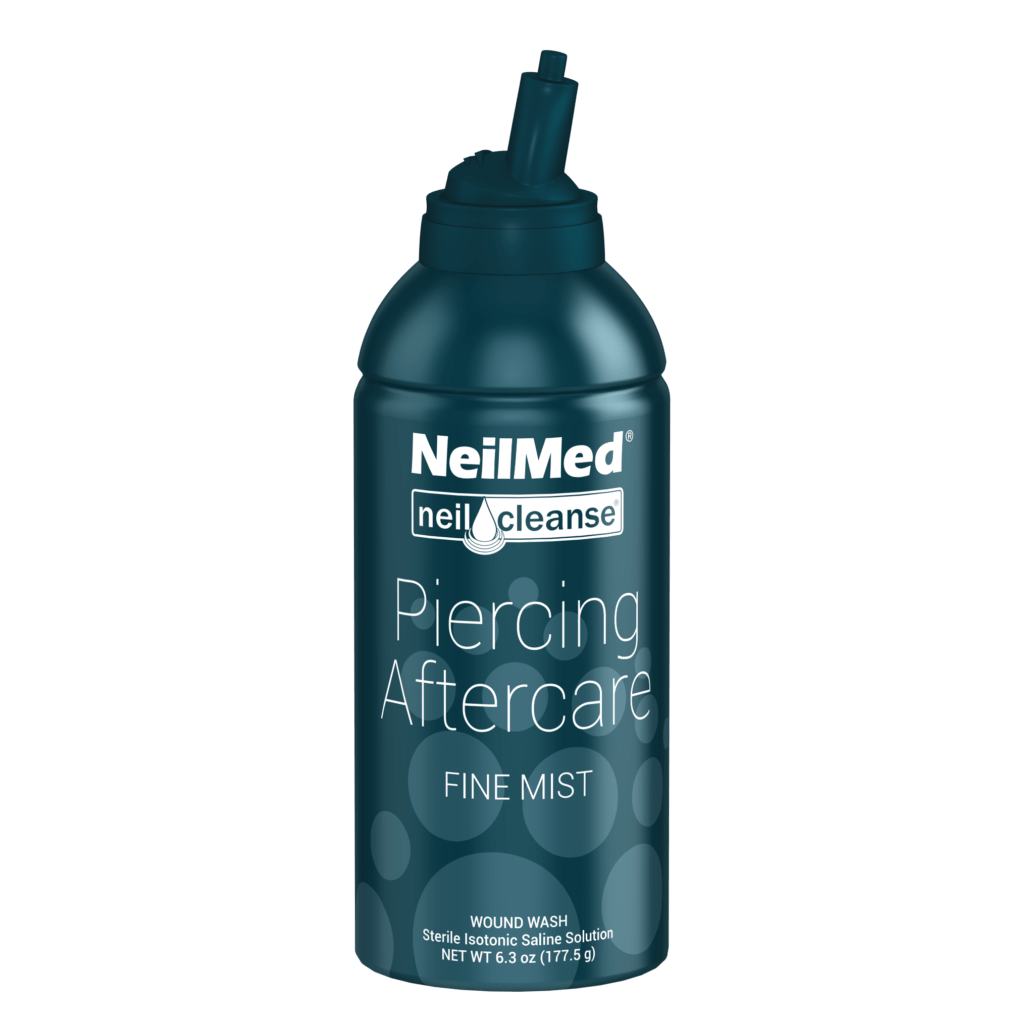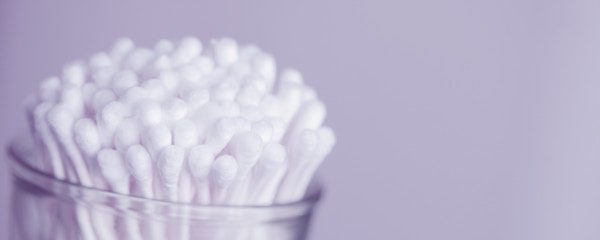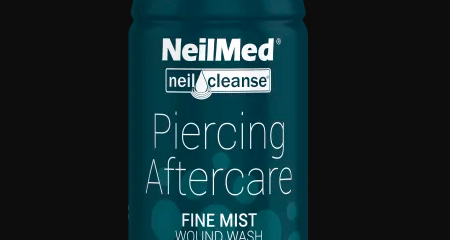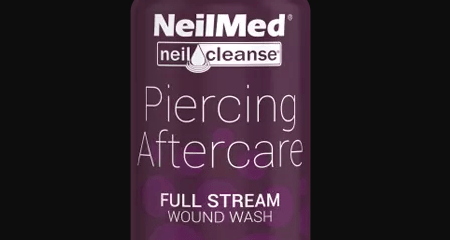Should I Soak or Spray? NeilMed’s Guide to Saline Soaks May 10, 2019 – Posted in: Informative – Tags: how to take care of a new piercing, saline baths, saline piercing aftercare, saline soaks, saline sprays
When researching proper aftercare practices, you’ll become inundated with tips, anecdotal truths, and other advice, some of which contradicts itself.
Part of the reason for this conflicting information is because everyone heals differently. While one person may experience an easy healing process with their new septum piercing, another might have a difficult time. The fact of the matter is that one healing practice doesn’t fit all, and in the end, you’ll have to figure out what works best for you.
One universal truth about piercing aftercare is that you must keep your piercing clean and many piercers recommend using saline solutions designed specifically for piercing aftercare. However, even here you can see some conflicting information about when to use a saline spray for surface cleaning versus a saline soak.
With so much information floating around about piercing aftercare, it’s hard to know when you should opt for which one. Lucky for you, we’ve put together a handy little guide. Here’s what you need to know about the difference between saline soaks and saline sprays.
On saline soaks
The name isn’t meant to confuse; saline soaks (also known as saline baths) are simply a bath of saline solution in which you soak your new piercing. You conduct a saline soak in a few easy steps:
- Fill a small cup with saline solution. The cup should be big enough to accommodate your piercing, and it should be filled with enough solution to completely submerge the jewelry.
- Let the piercing soak for 2 – 3 minutes.
- Remove the cup and gently pat the piercing dry with a clean paper towel.
What do saline baths do?
Saline baths help to flush out the piercing, draw out any discharge, and stimulate circulation. This helps keep the piercing clean, inside and out, for easier healing.
When should I conduct a saline bath?
Saline baths are important to clear your piercing from dead skin cells that can cause infection. In the beginning, it’s a good idea to do a soak around two times a day for any piercing type.
Some piercing types are more susceptible to infection, such as nose and lip piercings. If your piercing is in an area that sees a lot of exposure to foreign contaminants, it’s a good idea to continue doing saline soaks throughout your healing process.

Nose piercings and other piercings that consistently come in contact with foreign substances greatly benefit from regular saline soaks.
If you start to see signs of an infection or your piercing is having difficulties healing, you should increase your daily saline baths. This will help clean the inside of your piercing and clear away contaminants. If you’re concerned, please see a doctor. Don’t do a saline bath in lieu of medical attention.
Be careful not to do too many daily saline soaks. This can irritate the skin.
On saline sprays
The major difference between saline soaks and saline sprays is that sprays are intended for surface level cleaning while soaks clean the piercing inside and out. Saline sprays are designed for quick, on-the-go aftercare. The process is simple: spray the saline directly onto your piercing, and let it soak in. That’s it.
Unlike saline soaks, saline sprays don’t fully flush the piercing. This is why it’s important to do a combination of both saline sprays and soaks during the first weeks of healing in any piercing.
However, some piercings, like ear piercings, don’t always require saline baths throughout the healing process. After a few weeks, you can simply opt to spray the piercing 2 – 3 times daily to keep it clean.
Even for piercings that should need saline baths throughout the healing process, saline sprays are excellent for cleaning in between soaks or when your piercing gets contaminated by foreign substances while on-the-go.
Be careful with saline soaks; if you do them too often, it could irritate the skin, leading to infection or scarring.
What do saline sprays do?
Saline sprays clean the surface of your piercing.

NeilCleanse’s fine mist nozzle was the first of its kind, paving the way for easier aftercare practices.
Since saline consists of just salt and water, it’s safe to let the solution soak into your skin. Because you let saline sprays soak into your skin, it’s important to find a solution that’s all-natural and free from preservatives like NeilMed NeilCleanse Piercing Aftercare.
When should I use saline sprays?
Saline sprays are optimal for spot cleaning while on-the-go, and for cleaning practices in the later part of your healing.
Saline sprays are also great for those who may get a littl
e lazier with their aftercare practices. While we always recommend stringent healing habits, we know that life gets in the way, and some people struggle with discipline. If this is you, then saline sprays offer an easy aftercare solution that only takes a moment of your time.
For optimal aftercare, you should make use of both saline baths and sprays. Each has their place in the aftercare process, and they are important in their own ways. Everyone heals differently, and while one person might never conduct a saline soak in their life, someone else might find it imperative for their healing. Listen to your body, know your limits, and talk to a professional if you have any concerns surrounding your new piercing.







4 Comments
liangcx126 December 22, 2019 - 03:49
Will my ear get infected if I use saline sprays too often?
Meghan O'Neal December 31, 2019 - 12:52 – In reply to: liangcx126
Saline will not cause an ear infection by using too much.
Can You Sleep Without Earrings | PostureInfoHub September 11, 2021 - 11:07
[…] how to clean the skin around the studs two to three times per day with saline is simple and straight forward. The process involves washing the face twice daily before bedtime […]
kelly.sikorski December 13, 2021 - 03:13
Can I spray the fine mist directly onto my nose piercing or is it better to spray a cotton pad/ball and dab it on?